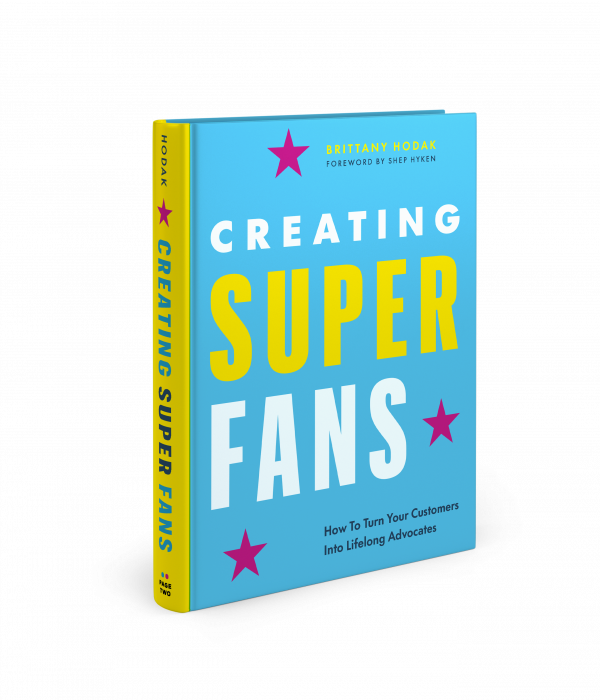Welcome to another edition of the Small Business Show with anchor Jim Fitzpatrick. Today, we’re pleased to welcome Brittany Hodak, entrepreneur, author, and keynote speaker, who discusses how small business owners can transform their customers into brand “superfans.” Hodak has worked with companies including Walmart and Amazon, led campaigns for celebrities like Katy Perry, KISS, and Dolly Parton, and was featured in 30 under 30 lists for both Inc. and Billboard.
You can order Hodak’s book called Creating Superfans: How To Turn Your Customers Into Lifelong Advocates here.
Jim Fitzpatrick:
So Brittany, thank you so much for joining us on today’s show.
Brittany Hodak:
Thank you, Jim. I’m so excited to be here with you today.
Jim Fitzpatrick:
So tell us a little bit about yourself because that lead in right there, man. I know a lot of people are listening, going, wow, this girl’s got a lot going on for a young lady. So tell us a bit about yourself and your entrepreneurial journey.
Brittany Hodak:
Yeah, well, I kind of became an entrepreneur by accident. I always wanted to work in the entertainment industry. I got my first job as a radio station mascot when I was 16 years old. And then I had the very good fortune that because my maiden name was Brittany Jones, the radio station said, “What can we do and call it Brittney Jones diary,” because of this Bridget Jones diary movie that’s coming out?
Jim Fitzpatrick:
That’s right.
Brittany Hodak:
And so I said, “Well, you could just have me interview the rock stars that come through town and we could put it on the website. You’re always talking about driving traffic.” And to my absolute shock, the station manager said, “Yeah, that’s a great idea. Just make a list of all the bands that you want to see.” So it became my job at age 17 to literally hang out with rock stars and brag about it on the internet, which kind of ruined any chances of me having a real job for very long. So while I did work in the music industry for a few years, it didn’t take that long for me to decide that maybe I could go it on my own and start my own company. And I did. When I turned 26, I launched a company called the Super Fan Company and was lucky enough to have tons of success, work with some of the incredible artists like the ones that you mentioned at the top of the segment. And now I’m a keynote speaker.
So I have had my hands on lots of different small businesses over the years. I was a tech executive for a while at a company called experience.com. So I know entrepreneurship and is so near and dear to my heart. Entrepreneurs are my favorite people on the planet and I’m so excited to hopefully share a little bit of wisdom for any watching today.
Jim Fitzpatrick:
Sure, sure. So there’s so many people that can relate to your story starting out, somewhat humble and building it into a business. And here you are today as a keynote speaker and a successful one at that.
But talk to us. In your opinion, at what point should a small business invest in branding? We hear so much about branding. Everybody says, “Do you have a brand? What’s your brand all about it? You building a brand?” So talk to us about that. How important are these things to small businesses such as a brand?
Brittany Hodak:
I love this question. A brand is so important for every single small business, because here’s the thing. Everybody has a personal brand, whether you know it or not.
Jim Fitzpatrick:
Right.
Brittany Hodak:
The minute you make the decision to sign up for your first social media site or do anything online for the first time you are digitizing your reputation, which is what we like to call a personal brand.
Jim Fitzpatrick:
Sure.
Brittany Hodak:
So the question is not, should I have one or not? The question is, are you in control of the one that you do have?
Jim Fitzpatrick:
Right. Great point.
Brittany Hodak:
And for entrepreneurs there is such overlap between your personal brand and your business brand.
Jim Fitzpatrick:
Yes.
Brittany Hodak:
So it is never too early to start thinking about your brand because essentially your brand is what allows a customer or a prospect to trust you and to choose you over a competitor.
Jim Fitzpatrick:
That’s right?
Brittany Hodak:
So if you don’t have one, you’re just a commodity.
Jim Fitzpatrick:
That’s right. And so many times my wife and I, if we’re looking for a company to do business with, and we’ll check out their social media or we’ll check out their website and on the website, it will say, check out our staff, because we’re so proud of our staff and you go right to the CEO and then you check out his or her social media, right? To your point, they do overlap, right? Because you want to learn about them a little bit, who am I doing business with? And oftentimes you’ll find out about who they are and what their personal beliefs are and their brand, so to speak on their personal site. So you’re right, the company website and the company branding, I should say the social media icons out there also flow right over to the personal side so often, right?
Brittany Hodak:
Yeah. And it’s not just the CEO. I like to say that-
Jim Fitzpatrick:
That’s right.
Brittany Hodak:
… Every employee is in the experience department.
Jim Fitzpatrick:
Yeah.
Brittany Hodak:
Because anyone at your company has the power to make or break that relationship with a customer or prospect.
Jim Fitzpatrick:
That’s right. That’s right. That’s a very good point. That’s very good point. So we want to create these super fans of our businesses, right. What is a super fan exactly? And how do you create them?
Brittany Hodak:
So I love this question. In the shortest possible terms a super fan is a customer who creates more customers.
Jim Fitzpatrick:
Okay.
Brittany Hodak:
So it’s a customer or a partner who has had such a great experience with your product or service that they advocate on your behalf.
Jim Fitzpatrick:
Okay.
Brittany Hodak:
They’re out there telling people how great their experience was, whether that’s by writing a review, whether that’s a personal recommendation that they make either online or maybe in-line at the supermarket or their kid’s soccer game or whatever. These are advocates out there who are choosing you at the exclusion of others and telling their friends to do the same.
Jim Fitzpatrick:
Yep. That’s great. And that’s what we need today, right? It’s even more important, in many cases than advertising or marketing itself is to just make those customers that you currently have, what you call super fans, right? So they spread the word. It used to be the best advertising out there was word of mouth. It’s still true today, right?
Brittany Hodak:
It still is. It’s been true since the beginning of time.
Jim Fitzpatrick:
Yeah.
Brittany Hodak:
I don’t know if this is the best example of word of mouth marketing or not, because maybe it didn’t have the best consequences, but I always say the earliest influencer marketing was Adam and Eve, like why did Adam take a bite to the fruit? Because Eve said, “This was awesome,” right?
Word of mouth works. It’s worked forever since the beginning of time. And it’s so important. And there’s so much to talk about influencer marketing today and people allocate so much of their budgets to influencer marketing. But the reality is everyone is an influencer. I am, you are, every single person watching this broadcast is. We all have people in our circles who will either take an action or not take an action based solely on us saying something. So if you can create an experience for your customers, that’s so remarkable, but that they can’t help but talk about it-
Jim Fitzpatrick:
Right.
Brittany Hodak:
… They’re going to talk about it’s and that’s going to create more customers.
Jim Fitzpatrick:
Do you feel as though social media is essential for every business that’s out there?
Brittany Hodak:
So it depends on where your customers are. For most businesses, yes. You need to have social media, if for no other reason, that when a customer wants to tell one of their friends about you, they can easily tag you in. So social networks are, of course, designed to keep users on the social networks.
Jim Fitzpatrick:
Right.
Brittany Hodak:
So it’s much easier to at tag and hyperlink to a person or company.
Jim Fitzpatrick:
Right.
Brittany Hodak:
Than to list a URL.
Jim Fitzpatrick:
Sure.
Brittany Hodak:
So I always say you need to be active on as many social networks as you want people to send you customers on.
Jim Fitzpatrick:
Yeah.
Brittany Hodak:
So depending on what you do, maybe LinkedIn is more important. Maybe TikTok is more important. Maybe it’s Instagram. But I would say for 99% of businesses out there, yes, you need to be active even if it’s just to have a profile with a great cover shot and your hours and your phone number.
Jim Fitzpatrick:
Sure.
Brittany Hodak:
And saying to people, “You can find us on our website.” You don’t have to be super active, but you need to have that landing page present so that somebody can tag you in when they want to refer to you. Because otherwise they’re going to just not refer to you.
Jim Fitzpatrick:
Sure. So share with us, from your perspective, what does effective branding look like? What should it look like today?
Brittany Hodak:
So it should look authentic to your brand. I have a five-part model that I like to teach people. I call it my supermodel. If you want to create super fans, you’ve got to be super. It’s very easy to remember. And the S in super stands for start with your story. And when I say start with your story, I don’t mean lead with your story. I mean, everything about your brand has to ring true to your story.
Jim Fitzpatrick:
Okay.
Brittany Hodak:
Why are you doing what you’re doing? Why are you the best possible choice for your prospects and customers? Once you have clarity on that answer, it becomes your north star to guide everything else that you’re doing.
Jim Fitzpatrick:
Right.
Brittany Hodak:
So there’s not a simple answer of what your brand should look like. It really depends on what’s the story you’re trying to tell? Who are the customers you’re trying to reach? How are you different from all of the competitors? And how can you convey that visually in a way that actually means something? Anybody can just pick a pretty font in a color. Why did you pick the font? Why did you pick the color? How does it all tie together to this larger story you’re telling?
Jim Fitzpatrick:
Talk to us about some of the dos and don’ts that jump out at you right now for branding for small businesses.
Brittany Hodak:
I would say one don’t is don’t overthink it. I have people say sometimes, “I have this brand right now and I really want to change it, but I’m afraid people are going to think that I’m changing it up too often because I just did it two years ago. Should I do it? Should I not do it?” And I always say, “No one is paying as close attention as you are.” If you can make it better, make it better.
Jim Fitzpatrick:
Right.
Brittany Hodak:
So don’t feel like because something has been your logo for 20 years, you can’t tweak it. The biggest companies in the world make small modifications and updates to their logo all the time. And so can you.
Jim Fitzpatrick:
Sure.
Brittany Hodak:
I would say another don’t is don’t try to be overly literal. You can have a logo that nods to who you are. You can have a brand that nods to who you are without hitting people over the face with it.
So don’t be too super literal. I would say do pick something that you love. If you don’t love it, your customers are probably never going to learn to love it. Your employees are never going to learn to love it. Be intentional about the colors that you choose, the fonts that you choose. One really important thing today when you’re picking a logo is to zoom it way, way, way out and way, way, way up, because you want to pick something that can look good as an icon on a phone. If you have an app, think about how small that’s going to be.
Jim Fitzpatrick:
Yeah.
Brittany Hodak:
Or how small your icon in a social site would be. And then also think about how something’s going to look on a billboard.
Jim Fitzpatrick:
Yeah.
Brittany Hodak:
So you’ve got to choose something or choose iterations of a couple of different variations of a logo that’ll work really, really small, but also really, really big.
And then my final one, I would say, make sure that you’re telling a consistent story with your brand everywhere because you don’t want people to look at your social pages and see one thing and then go to your website or go to your store and be like, “Wait, is this a different company? Because this looks nothing like what I thought I was getting.” So you want to have consistency so people don’t get confused.
Jim Fitzpatrick:
That’s right. And we should note that a brand isn’t necessarily just a logo. It’s also how that customer is dealt with in your stores and your pricing and your customer service and your ratings and your reviews and what your core values are. That’s really the branding in its entirety, right?
Brittany Hodak:
Oh yeah.
Jim Fitzpatrick:
I mean people might see a, might see that logo from Nike, but they know what that stands for, right? They know it stands for quality and great running sneakers or great athletic shoes or what have you, right?
Brittany Hodak:
Oh, 100%. And I said earlier, everyone in your team is in the experience department and that’s so true. One of the things that’s so inspiring, but also a little bit terrifying as an entrepreneur, is to realize your brand is not what you say it is. As hard as you work on that clever website copy-
Jim Fitzpatrick:
That’s a good point.
Brittany Hodak:
… On those great ads your brand is what a customer tells somebody else you are.
Jim Fitzpatrick:
That’s right. Great point.
Brittany Hodak:
That is it.
Jim Fitzpatrick:
That is a great point. So Hey, in our last moments here together, share with us because you’ve been very successful in building your business and now a very successful keynote speaker to talk about it. What advice would you have for others that are considering to go into business for the first time on their own?
Brittany Hodak:
I would say, just go for it. It is such a liberating feeling to trade working for somebody else with working for yourself. And I know when I launched my business, I had all these contingency plans. I was like, “Okay, if it doesn’t work in a year, I’ll just go work for somebody else. If I haven’t hit profitability by this stage, I’ll, you know, go get another job.” And I never really took the time to say, “What if it works? What if it’s successful?”
Jim Fitzpatrick:
That’s right.
Brittany Hodak:
And I’ve been able to build down multiple multimillion dollar businesses. And I would say, you’ve got to trust yourself. You’ve got to invest in yourself and know that you are worth it.
Jim Fitzpatrick:
That’s right.
Brittany Hodak:
I always hate when entrepreneurs are afraid to bet on themselves or afraid to invest in what’s going to be best for them. You are the absolute best investment on the planet. You should 100% bet on yourself and treat yourself as such.
Jim Fitzpatrick:
That’s fantastic. Highly recommend you do just that as a small business owner, or as any business owner for that matter. That you need this kind of information.
So Brittany, thank you so much for stopping by the show. Very much appreciate it. I know that our subscribers and viewers will get a lot out of your visit here today with us. So thank you.
Brittany Hodak:
Thank you for having me, Jim. I really appreciate the time and I want to wish all the best luck to everybody watching.


While you’re here, don’t forget to subscribe to our email newsletter for all the latest business news know-how from ASBN.







